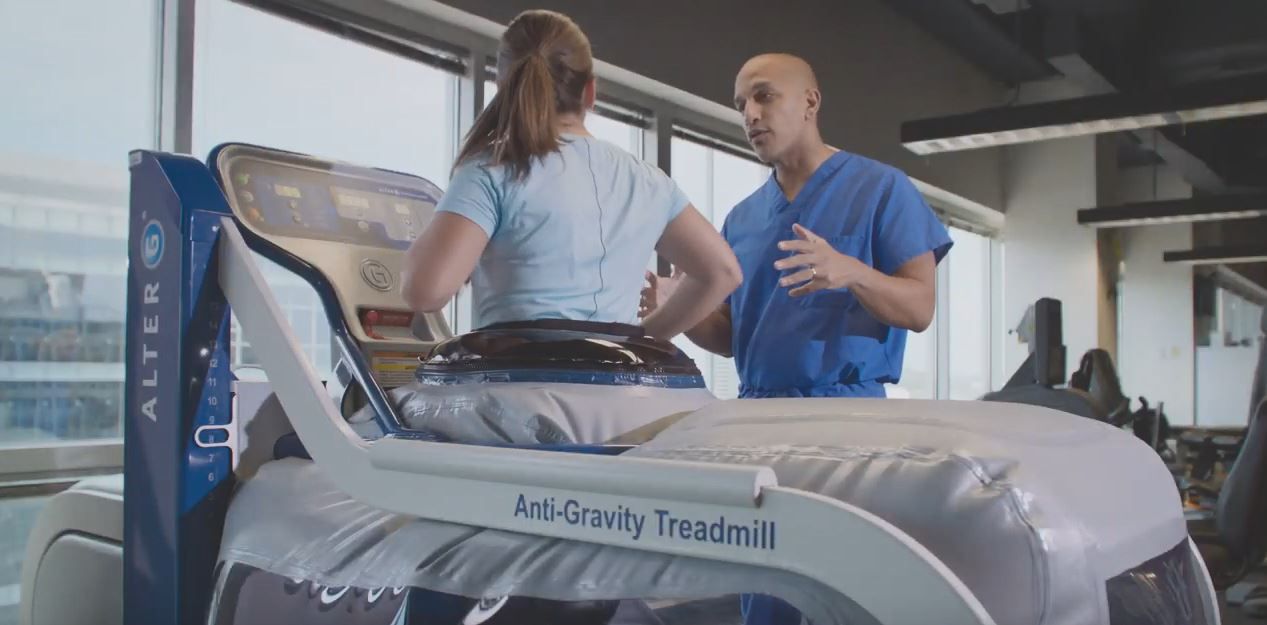Returning to a Full Life After Hamstring Surgery

Mariam spends every day serving patients in her role as a Clinical Pharmacy Specialist at St. Joseph's Hospital in Atlanta. She never thought she would end up as a patient herself until one day an accident left her with a torn hamstring.
When most people hear about hamstring tears, it's usually associated with athletes competing at the highest level. This is not always the case! Mariam injured herself while performing a seemingly innocuous activity: pushing her nephew on a swing set. As she pushed him higher and higher on the swing, something suddenly went wrong.
"I planted my left leg and moved forward, and it was like a cartoon character slipping on a banana peel," says Mariam.
Unfortunately, she placed her foot on a wet patch of grass, causing her to slip when she put her weight on it.
"I heard a pop right when I slipped. I landed in a split position; I was in a lot of pain and I couldn't stand or walk.
Sensing something was wrong, Mariam's nephew ran inside to inform the other adults what had happened.
"For that, we call him Harrison the Hero," says Mariam, laughing.
Emergency personnel transported her to St. Joseph's Hospital where an MRI revealed the injury and Dr. Evander Fogle of Resurgens Orthopaedics made the diagnosis. Dr. Fogle informed Mariam that the tendon which attaches her hamstring muscle to the pelvis had been completely severed. Injuries to the hamstring muscle are not always so serious and most of the time they heal on their own. Tendon injuries on the other hand, often require a combination of surgery and physical therapy to heal properly. Because the gap between Mariam's tendon and the bone was not that wide, Dr. Fogle hoped surgery would not be necessary, as long as she kept her leg elevated to prevent the tendon from retracting further down into her leg. Dr. Fogle put Mariam's leg in a brace and sent her home on crutches. At the follow-up visit though, the gap did become wider, and at that point Dr. Fogle recommended surgery.
Dr. Fogle performed an outpatient proximal hamstring tendon repair and Mariam was well enough to go home the same day. She had limited mobility but was able to heal and rest at home. At the four-week follow-up, Dr. Fogle checked "to see if I had any numbness or nerve damage; he checked the incision site to make sure it was healing nicely. He said everything looked great!"
At that stage, Dr. Fogle felt it was time for Mariam to begin her physical therapy and for that, he turned her over to Mark Wentworth, a certified athletic trainer and physical therapist at Resurgens Orthopaedics Rehabilitation Center.
"I had my first meeting with Mark and he asked me what I wanted to get out of this. I said, "I want to be able to walk again! I want to be 100% back to normal; I want to run; I want to swim; I want to do yoga."
Mark responded with a promise that she would be running on a treadmill within two weeks. Though skeptical, Mariam steadfastly followed Mark's recommendations for specific stretches and exercises that would help her fully recover.
"Slowly but surely, every day got easier. I could get in and out of bed more easily; I had less pain", Mariam recalls.
Mariam spends every day serving patients in her role as a Clinical Pharmacy Specialist at St. Joseph's Hospital in Atlanta. She never thought she would end up as a patient herself until one day an accident left her with a torn hamstring.
Two weeks later she met with Dr. Fogle, "He was so happy with my progress. He could tell I was following Mark's direction. He said I would be able to stop using the brace soon because it was actually inhibiting my movement at this point.
Sure enough, at her next physical therapy appointment, Mark informed Mariam that this would be the day when she walked on a treadmill, something she hadn't been able to do in at least seven weeks.
Miriam began her walking therapy on a state-of-the-art machine called the AlterG Anti-Gravity Treadmill.

The AlterG Treadmill is the world's first and only treadmill using NASA based anti-gravity technology, and it is designed to help patients in their short-term rehabilitation programs. AlterG Anti-Gravity Treadmills allow a patient to lessen their body weight to reduce the impact on their joints which enables faster rehabilitation, safer conditioning, and weight loss - all factors which can reduce major obstacles associated with recovery and rehabilitation. These machines are contributing to better patient outcomes and Resurgens Orthopaedics offers them at our St. Josephs and Lawrenceville locations as part of our rehab programs.
"First time on the treadmill, I was excited. I was still pretty timid about walking on my own but I was excited to know I would be able to use my leg again without re-injuring it. The fact that I could walk again, essentially pain-free, was huge."
The integrated Sport Medicine team at Resurgens Orthopaedics allows for thorough communication between our physicians and rehabilitation. And with the skill of physicians like Dr. Fogle, and the dedication of Mark Wentworth and the Resurgens Orthopaedics physical therapy team, Mariam is now able to walk without much difficulty. Although her recovery is still ongoing, she's determined to get her mobility back. She does have one recommendation for patients living with similar injuries:
"Do your physical therapy. I went from literally not being able to walk to getting my life back. Recovery is a marathon, not a sprint."
And as for the team at Resurgens, she had this to say:
"You're in good hands with Resurgens!"
Mariam, all of us at Resurgens Orthopaedics are so impressed with your commitment to recovery; we wish you all the best as you move forward, continuing to get stronger every day.